$2M+ of lies to win power
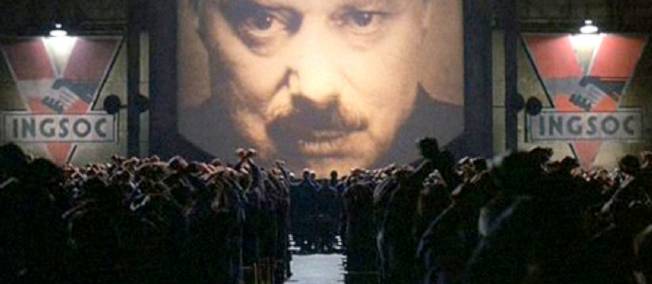
I believe in truth in advertising. So does the commercial TV regulator that demands evidence for any claim you want to make before they give your ad clearance to air. Unfortunately for the voters of NSW, political parties are allowed to say what they want in an ad because they aren't answerable to any of the rules mere brands and businesses have to conform to.
If I made a fraudulent claim for a client in an ad, (for instance the kind of price saving offer mobile phone plans were notorious for before being fined into transparent pricing), the ACCC or ASIC would come after me. This election has seen Labor and unions spend twice the Liberals. Most of that $2,500,000 was on ads that say electricity prices will go up if Baird sells 49% of the poles and wires. It's a lie.
Their ads scream this lie despite ACCC chairman Rod Simms saying this isn't the case. Even the Australian Energy regulator is on record that whoever owns the poles and wires in NSW after the election he will insist they reduce their prices by 20-30% over the next five years. There is no evidence for the claim made in Labor's ads that I believe would have satisfied the broadcast standards that commercial advertisers have to comply with. In fact, there is much historic evidence from previous power privatisations showing prices are lower outside government ownership. This has been acknowledged by such Labor luminaries as Bob Carr, Morris Iemma, Michael Costa and Anna Bligh when they attempted to sell the poles and wires under their governments.
It frustrates me as a professional marketer that in the 21st century political parties of any persuasion can play 1984 mind games with the truth and run them in prime time. The ABC Fact Check merely called Foley's ad pitch "spin". I prefer the robust language of former Labor Energy Minister and ACTU president Martin Ferguson. He says Foley's spin is "rank opportunism and scaremongering... sending a clear message he doesn't care about jobs and energy security."
Politicians' ad claims are officially accountable to... themselves
Here is the law (or lack of) that applies to political advertising as published by adstandards:
"Currently, there is no legal requirement for the content of political advertising to be factually correct. Complainants are advised to raise their concerns with the advertiser directly and/or with their local Member of Parliament."
Maybe we should just ban political advertising, we banned cigarette ads for telling us porkies.
Read MoreThe optimum lengths of social media
People now have short attention spans. So to connect you have to cut through. Keep it honest. Keep it simple. And keep it true to your brand. As for length, keep it short.
71 - 100 characters
Posts with 40 characters get 86% more engagement
Google+
25 characters
40 characters
Linked In
Posts 16 to 25 words long
Videos
Average length watched is 2.7 minutes
Read MoreThe average customer has an attention span of


How does a brand catch a customer's interest when their attention span is now less than that of a goldfish? I spent a few seconds Googling to discover the average person's attention span has shrunk since 1998, by 11 minutes.
The average attention span today is 8 seconds
The National Center for Biotechnology Information says our attention span is now 1 second less than goldfish. What hope does a brand have to convince us to buy?
Consider a tube of toothpaste. The average main grocery buyer now spends less than 20 minutes in the supermarket for the big weekly shop. With over 10,000 items to choose from it's not surprising when faced with so many options brands are struggling to catch shoppers' interest. At the dental care section 27% of shoppers walk away without making a decision.
You may be aware Australians have never been better educated, the number of university graduates has almost quadrupled since 1986, from 6% to more than 21%. Are we any smarter or better prepared to make purchase decisions?
We are exposed to five times the quantity of information every day than we received 30 years ago, (you may be surprised just how many ads we are exposed to). Yet we have less free time to consider. The Economist explains that time poverty is a wealth syndrome, the more money we have the more we value our time and the more choices we are confronted with to spend that time. At the other extreme, cash strapped people have largely given up trying to decipher so much information, they are influenced by price like never before.
Price is increasingly winning over brand appeal. It's at the heart of the growing success of ALDI – less items to choose from, mostly unbranded, all at lower prices. This has seen their share of grocery sales reach 10%, a big slice of the market brands are mostly missing.
Even brands are struggling to be seen in Woolworths
According to Woolworths own research "more than a third of the items in Woolworths’ supermarket trolleys are purchased on promotion." That's an increase of 10% a year for the last two years.
"Australians hunting for bargains are the big winners, with one in four customers (25%) purchasing nearly half of the food and drinks in their trolley on special."
How do the retailers manipulate the time poor if not with price?
One journalist recently warned shoppers something brand marketers pay dearly for:
- The most expensive brands, or the ones being promoted heavily, will always be on the two shelves that sit between waist and shoulder height.
- Cheaper products are often stocked below knee height.
- Supermarkets know that you may only want milk so put it at the back of the store in the hope you’ll pick up items you don’t need.
Not only are the retailers asking brands for price rebates, Private Label substitutes are also catching once impregnable brands in a pincer movement. So if you believe in protecting the value of your brand you'll probably want to avoid discounting too often. Only the biggest and most desperate can afford to pay Coles and Woolies to be on promotion. In the past sales managers have encouraged the benefits of putting products on promotion to drive sales. Does it still work in the era of short attention spans?
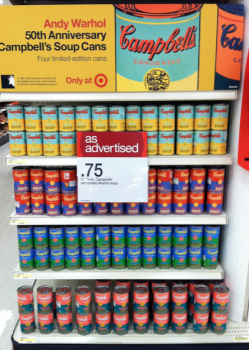
My associates at consumer benchmarking specialists B4P spent a year researching the impact of sales promotions at Point of Purchase (POP). The clients were several of the largest global FMCG companies that are active promoters in Australia's supermarkets, every week of the year. They tested awareness before promotion, cut through in-store, trial, impact on sales and recall several weeks later.
Across all promotion types, (price promotion, competitions, bundled offers and bonuses), shoppers generally don't notice any of it. This is despite multi-million dollar spends on displays, cardboard, posters, banners, gondola ends and shelf strips. Most in-store promotions have become invisible.
Earned and shared media can still gain attention
As we learned over seven years growing Pacific West from a $6million pa frozen seafood minnow to a $38million challenger brand, you can drive shoppers to your product by creating original content to tell your story and social media to spread the word. Just remember your audience has a short attention span. Here is a charming infographic that shows the optimum number of times to post content on social media channels.

Read More
Think big, or detail will kill your business


"Look, I said I'd bring you the report on micromanagement,
just give me a minute!"
Stop sweating the small stuff, especially now there's so much of it. New technologies allow us to gather data on just about everything. So it's become accepted practice for marketers and sales to invest in new ways to gather stats and report to senior management. For those of you wondering what's the point, it has now been proven the more a business spends on technology, CRM systems and sales data, the less well it performs in profitable conversions.
The more technology marketers use, the worse the results
Sounds like a contradiction, but the research undertaken by Peter Strohkorb into sales and marketing collaboration in 2013/4, simply proves the more systems teams add the worse the sales results. It's symptomatic of what the authors of Blue Ocean Strategy postulated over a decade ago. A typical strategic plan is usually based on a plethora of research from silos across the business which forces management to dwell on detail. Management becomes paralyzed by information overload.
The businesses that thrive are the ones that step back and look at the big picture using a customer centric view of what could be possible. Here's how it works.
Focus on the big picture to create a Blue Ocean Strategy
| Head to head competition | Blue Ocean creation | ||
| Industry | Focus on rivals within industry | Looks across alternative industries | |
| Strategic group | Focus on position against competitors | Looks across strategic groups | |
| Buyer group | Focus on better surving current buyers | Redifines who buyers can be | |
| Scope of product /service | Focus on costs/maximising value of current offer | Looks across complementary products/services | |
| Functional/emotional orientation | Focus on price/performance improvement | Rethinks the orientation of the industry | |
| Time | Reacts to industry changes as they happen | Participates in shaping external trends over time |
With a Blue Ocean strategy, you can implement a clear brand building campaign
We've found time and again, once clients re-visit what they can be, the task of growing the business becomes clear. Our methods to help create clear differentiation set the business up for challenger brand growth. With a single minded compelling tag line that sets them apart, big picture thinking helps refresh the business. There is new enthusiasm we harness to recreate the brand and relaunch. The way is now clear to become a price setter, not taker and drive sales conversions.
See some of the ways a refreshed brand can improve profitability.
Read MoreFor a nation of gamblers we're marketing risk averse
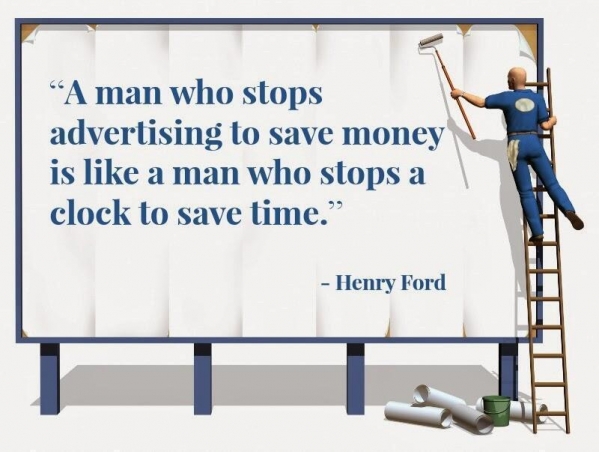
The companies that rated best for effective marketing, according to a recent Gartner study, were the ones that spent the most time understanding their customers. Businesses that are introspective and fearful of action will lose sales to those actively talking to customers and prospects.
How do you guarantee marketing success?
Jan-Patrick Schmitz, CEO of Montblanc North America, says "it obviously starts with the CEO. If he or she doesn’t understand that the business is about the customer and not operations, the CMO is going to have an uphill battle. Understanding your customer is about understanding what your business is and what your business will grow into.”
It's not a lottery, once you understand what customers want from your product or service, marketers that advocate for the customer in the boardroom will win.
Get the message right, then the risks are reduced irrespective of the mediums you then try. If you do understand your customers true needs and what they value most, and built your offer to satisfy those desires, it's time to check out the latest ways to advertise and connect.
Read MoreAussie business struggles, time for a creative way out


Will our kids ever be able to afford to buy a house? Can they even afford to rent? Here in Woolloomooloo 2 bed flats start at $1,000 a week, unfurnished! Unemployment is on the way up, mining investment on the way down. Coles and Woolies continue to squeeze farmers and FMCG brands while bricks and mortar retail is flat.
The big 4 banks are making record profits on higher margins than ever. If you are a small to medium business they probably won't give you a loan. 20 years ago 75% of bank lending was to business, now 75% goes to funding ballooning house prices.
This chart shows the decline in business investment post GFC
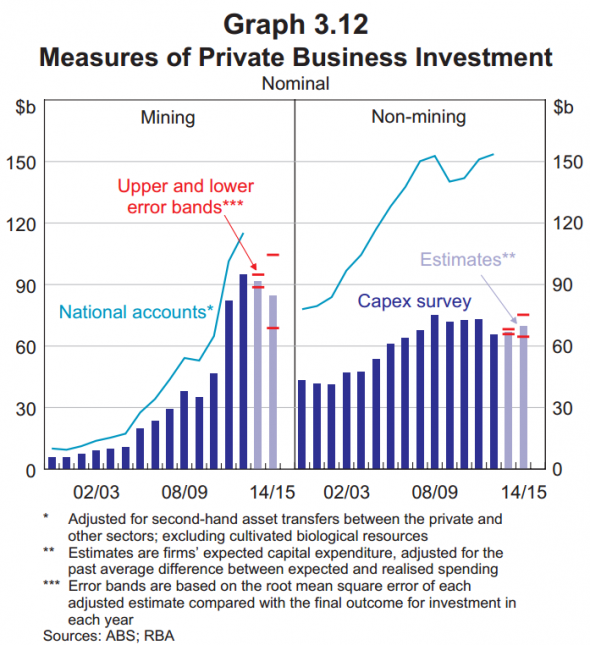
If businesses aren't investing in themselves, how can they grow let alone survive as the Internet destroys traditional business models?
Most managers have spent the last 6 years cutting and seeking efficiencies, hoping if they hang on long enough the market will recover. While local businesses seem to think it's conditions that are tough, World Bank figures show the world is booming – output was up $US75 trillion last year, which is about 20 per cent higher than the pre-GFC peak. 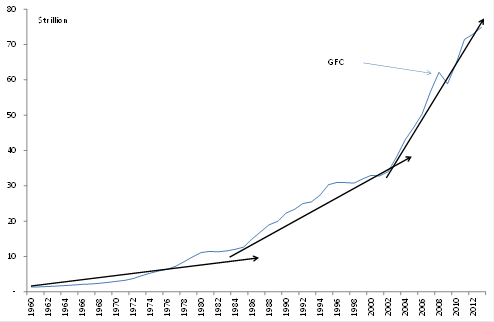
The world is moving on
Australians need to look outwards and recognise there isn't going to be a return to the way things were, the new reality is more rapid change and creative destruction. I use the word creative discerningly. It's the best way to describe the increasingly global competitive situation most businesses are struggling to get their heads around.
Historically change came slowly and could be managed by gradual adjustments of pricing, distribution or inputs. Not any more.
Enabled by the Internet, we now have Google replacing entire distribution channels with a search box. The Cloud has enabled brands such as Xero to offer with a lower cost and better service to leapfrog long established businesses like MYOB that relied on annual software upgrades. Social media has empowered determined consumers to "out" entrenched self-serving business practices, just look at CommBank's conflicted financial advice scandal that could cost it over $100million. (Or ANZ's Timbercorp scam and Macquarie's financial planners rort.)
These are all examples of a new business environment. New challenges require new thinking. A survey of over 300,0000 managers published by Harvard Business Review shows both CEOs and the next 3 levels of management aren't equipped to think outside the square.
The most important skills as rated by managers
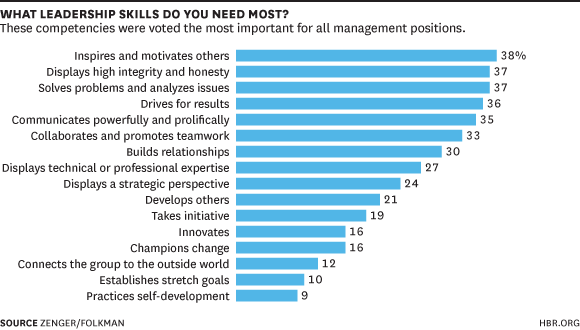
Perhaps the skills that are most needed today to deal with the rapid pace of change are the ones required to find creative ways to refresh and relaunch a business. Yet the survey found these are the least valued by management. Can you imagine how the people behind some of Australia's most successful businesses would rank themselves for the skills on the list? Like the young pair behind Atlassian, ten years ago a start up now worth $3.5billion. Or Boost Juice, Cochlear or Challenger, Seek or Xero. How important to their success are the more creative skills most managers in the survey dismiss?
Creative thinking skills
Innovates
Champions change
Connects the group to the outside world
Establishes stretch goals
Practices self-development
You may be interested to see evidence of how creative thinking adds value in this time of digital disruption. UNO helps challenger brands grow by encouraging and mentoring these creative skills that most managers have underutilised. Download our formula for growing challenger brands here.
UNO's one time client at Choice Christopher Zinn explains more on the new influence of the determined consumer.
Read MoreWant to see where marketing is headed?

Technology is changing everything in our world. Marketing isn't just following the trends, today marketers are actually more likely to be using new technologies to drive change within businesses than the IT department.
I wrote recently that Gartner has found the average CMO now spends more on IT than the CIO. It's all about understanding what the customer wants, then finding what technology can now do to give it to them.
Big Data driven future for marketers
Here is a chart I came across that helps explain where we are today and where we are heading. Sooner rather than later.
Just click for a bigger view of the future of marketing.
Read MoreWant a strong brand? Here's one we prepared earlier
What's in a brand name?
Money in the bank if you choose the right one, or an uphill battle and wasted dollars if you get it wrong.
Your business is your baby, and just like your first child, choosing a name can be fraught. Rather than show stats or a share a list of "most popular brand names of 2014" or cherry picked research to explain the pros and cons of what makes a good brand, I'm going to share 30+ years of trial and error and what it's shown me actually works in the real world. Not just what sounds good when shared with your spouse when working through the choices lying in bed late at night.
How a brand name change delievered a 3000% return
City Mutual had been around for over 100 years, yet onlythan 2 in 100 Australians recognised it. Three years later it was the best known investment and insurance group after AMP, having changed it's name to Capita.
Buying IBM means you won't get fired
Managers for decades have filled tenders, often at higher prices, knowing the board would never question the decision. Every time a client comes to me saying they want to call their business a series of initials they quickly use IBM as an example of why it will work. You can forgive their missunderstanding of what makes a brand. Unless your over 100 years of age you would necessarily know International Business Machines gained it's reputation for deivering reliable and ofte leading edge typewriters and for fifty years before it abreviated it's name to the initials that sat kneatly in the corner of millions of machines in office desks around the world. Today they business is in consulting, so Business Machines wouldn't be apt.
How to make a splash
Local businesses need to think of global consequences
When IFX Markets, a UK listed financial services business wanted to test market a business model in Australia for global roll out, the question of the right name came up very early in discussions.
Read MoreHave Aussies forgotten how to make things?


If you're anything like me, you enjoy a weekend trip to Bunnings. Today there are more things to buy than ever, for less than when our fathers took us to the local hardware decades ago. Where once tools and taps and barrows and bolts were manufactured in Australia, most of this stuff is made in China.
Most of us would agree Australia's manufacturing sector has been destroyed by cheap Chinese imports. What hope is there for Australian made? With the help of some lateral thinking, maybe more than most think.
The end of the made in China boom?
Robert Gottliebsen reports China's remarkable gains in productivity and standards of living were all achieved with borrowed capital and technology. Alan Greenspan points out that no Chinese companies feature on the annual lists of the world's most innovative companies -- nearly half of those lists are made up of American companies. This is leading to a narrowing productivity gap between China and the US, which is putting serious pressure on the Chinese economy.
That's right, don't underestimate the power of first world creative thinking when matched against the cheap cost of third world manual labour. Here are a couple of examples from my dealings over the last year.
Australia leads the world in compression fabric design
 I remember twenty years ago most Australian clothing manufacturers closed their local factories and set up workshops in Fiji where labour was cheap. Now most clothes sold here, even in stores like Zara, are made in China or Pakistan by one suspects slave labour. Yet in some areas of fashion we continue to lead the world.
I remember twenty years ago most Australian clothing manufacturers closed their local factories and set up workshops in Fiji where labour was cheap. Now most clothes sold here, even in stores like Zara, are made in China or Pakistan by one suspects slave labour. Yet in some areas of fashion we continue to lead the world.
Our client Quick Response is a local family business of almost 20 years who are still designing and making swimwear and compression garments locally. What's more, they manufacture using Australian made fabric.
In fact Australian compression fabric is the most technologically advanced in the world. It's the result of research and innovation that over the years has been tried and tested by our champion swimmers in those body hugging suits.
UNO have built an e-commerce site so you can buy the world's-best QRS compression garments direct, for less than sports brands that are usually made in China and Indonesian from inferior fabric.
Still open: a local manufacturer of timber shutters
Thirteen years ago Open Shutters was one of UNO's foundation clients. While cheap Chinese shutters have decimated most local manufacturers, Open continue to do business by concentrating on innovation. An obsession with quality design, investing in advanced machinery and only using sustainable timbers continues set them apart.
While white paint may disguise the compromises of Chinese made shutters in the short term, having been in the market now for several years they are proving to peel, bow, crack and break. The fact Open's product is built to last sees them gaining repeat sales over two decades on. What really makes the biggest difference is the way Open think: 
What truly lifts them to the top of their category in the world is the design thinking process they apply in everything they do. When suppliers tell local architects or designers their ideas aren't possible, Open finds a creative way to deliver.
Could robots save Australian manufacturing
If you still doubt the power of creative thinking over cheap labour, consider this. Last year McKinsey released a list of the things that would change the business world. Near the top of the list was advanced robotics: robots with better and better senses, dexterity and intelligence that can automate tasks or help humans or even operate on us more effectively than... humans.
To quote the numbers:
• 170%: growth in sales of industrial robots 2009-2011,
• 320 million: manufacturing workers (12% of global workforce), and
• $2-3 million: cost of the 250 million annual major surgeries.
Here's what robots could do:
"Advances could make it practical to substitute robots for human labor in more manufacturing tasks, as well as in a growing number of service jobs, such as cleaning and maintenance. This technology could also enable new types of surgical robots."
Closer to home, when I underwent keyhole surgery a few months back, I could have chosen to be operated on by a robot designed in the US for remote controlled surgery on the battlefield. My gap cover wasn't enough to cover the extra cost, but the cost gap will quickly close. It's another reminder the changes in our lives will more likely be shaped by innovation than the global oversupply of cheap labour.
If you are a manufacturer the message is clear, forget cost cutting, start thinking and get marketing.
Read more on how to rethink your business.
Read MorePerception or Reality? Customers now decide


Over 50% of people don’t trust financial advisers. So I was told on the news last night. If you have ever been to see an advisor you’ve probably come away with the perception that they aren’t telling you everything straight. Commbank’s multi-million dollar financial planning scandal has proved perception IS reality when it comes to advisors.
For decades when a business advertises a product, whether baked beans or an investment, the words and claims made are open to scrutiny and have to be THE TRUTH. You have to deliver on the promise or you are liable under a number of ad standards, ASIC and ACCC rules. If you sell a financial product face-to-face most of these rules don’t seem to apply or be enforced.
Big 4 Banks still traditional marketers
What the big 4 banks and AMP have got away with is a classic exercise in traditional marketing methodology – control the distribution channel and you control both pricing and product. By using different brands they have been able to sell the same products to an unsuspecting public. Most people haven't realised 80% of advisors work for groups owned or aligned with just 5 product providers.
Most people think they are seeking financial advice, when what they are getting is a sales pitch. How can anyone be given genuine choice when of 18,000 advisors only 31 are truly independent? We’ve all been buying Home Brand super for years and haven’t known it. Here is a list of just some of the hundreds of “brands” just 5 providers have sold their own products under:
Cavendish AMP
Charter Financial Planning AMP
Garrisons AMP
Genesys AMP
Hillross Financial Planning AMP
Ipac AMP
Avanteos Commonwealth Bank
Colonial First State Commonwealth Bank
Commonwealth Financial Planning Commonwealth Bank
Count Financial Commonwealth Bank
Financial Wisdom Commonwealth Bank
Witaker McNaught Commonwealth Bank
Apogee NAB
Garvan Financial Planning NAB
Godfrey Pembroke NAB
Lend Lease Financial Planning NAB
Meritum Financial NAB
MLC NAB
Elders Financial Planning ANZ
Financial Services Partners ANZ
Millenium3 ANZ
OnePath ANZ
RI Advice (RetireInvest) ANZ
Sentry ANZ
Asgard Westpac
BT Westpac
Pact Accountants Investment Group Westpac
KPMG Financial Planning Westpac
Securitor Financial Group Westpac
A couple of rogue CommBank advisors who ripped off investors for millions is just the tip of the iceberg of poor brand values. Ian Narev says the business won’t suffer. I suggest the era of brand equity built upon decades of million dollar perception-shaping advertising is over. The Internet has democratised the share of mind of customers. Does Narev not understand this? Instead of changing his business model he returned from holidays to push the button on a million+ dollar ad campaign trying to reassure customers they are fixing things. This old school reaction won't preserve brand equity long term. Here’s proof.
Try Googling CommBank financial planner. This is the result I got:
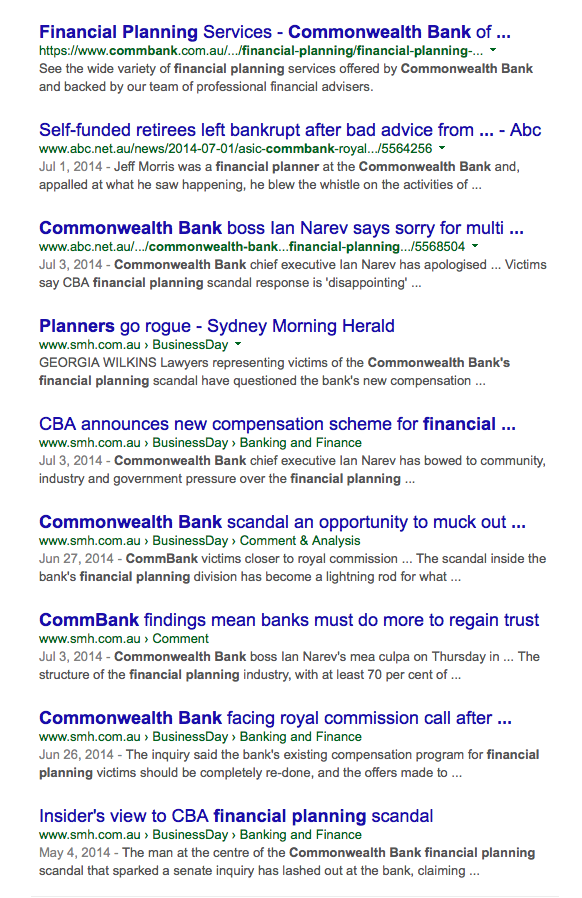
Last week we saw the government roll back the FoFA laws that were supposed to make hidden and trailing commissions illegal. Despite some wordy amendments from Clive Palmer, there is still no ironclad law that insists advisors can’t sell you a product because they get a kickback, not because it’s the very best choice for you.
Challenger brands will win with customer centric marketing
Legislation may not stop the consumer unfriendly practices of big banks. Social media and the empowered consumer will. And new technologies will see challenger brands that build financial product and service offers around what customers actually want will grow at their expense. Coles new deal with GE Capital to offer loans is just the start. I'll leave the last word to a consumer active on social media:
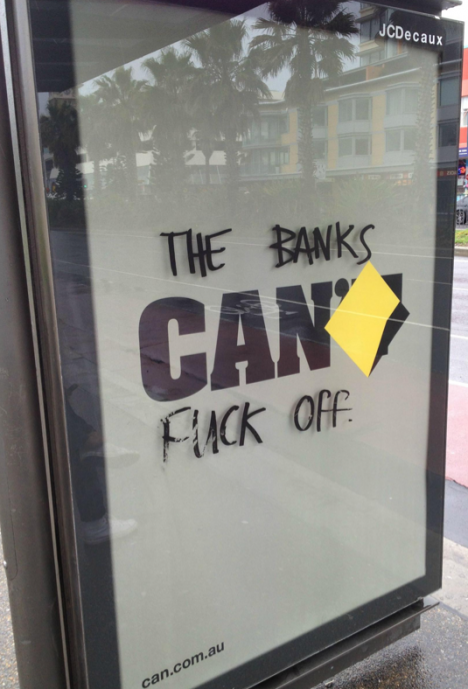
Why the CEO has to be the chief blogger

Successful social media strategy starts at the top of every business
It's misguided to think social media can simply be delegated to the youngest in the business, or outsourced to a digital agency. Social media is simply another relationship management channel. So it makes sense the strategy of what will be discussed in social media and what won't lies with the CEO. Social media is the one place the CEO's message can get through direct to the individual, without being filtered.
So if you're the CEO, consider this medium as your direct way to have a personal conversation where you can champion what you believe in. Before you begin, reconsider what you want your business to be known for. Ask yourself what is at the heart of why people should buy from your business, rather than your competitors?
Recent research by PR firm Weber Shandwick shows social media has positive impacts on business. (Click to enlarge.)
This simple checklist will help frame the social media agenda for your business
- What is the purpose of the business, what will success look like?
- What is the business strategy?
- What does the business believe in?
- How does it add value?
- What are its beliefs and ethics, its reason for being, its mojo?
- What is the business story? The way you express your differentiation, the reason for customers to choose you.
- Who does the business want to help? Who do you want to leave for your competitors to lose time or money trying to please?
- Who does the business want to influence? The gatekeepers to your prospects, or perhaps the well connected people who might bad mouth you through ignorance?
- Who does the business want to work with? Do you have affinity partners or associations you can share your blogs with?
- What kind of people does the business want to attract? It now matters what you look like in the blogoshere because it's the first place most potential employees will check you out.
Reputation risk has been elevated by social media
As equally important as having a social media presence is what you say. Being active across social media brings new risks. What is published online stays online, potentially forever. No wonder reputation risk is now the number one concern of CEOs globally according to the latest report from Deloitte.
Perhaps if more CEOs took control they would minimise the risk of staff who know less being the main originators of social media conversations. The CEO is best placed to set the agenda, staff can then follow through.
According to research by Weber Shandwick, more than six in 10 CEOs are already posting content on company websites. Yet only 18 per cent of the CEOs surveyed participated on social networks. The chart above gives an overview of the survey findings. Interstingly, 80% of staff want to see their CEOs on social media, largely because it's where they want to keep up to date.
I feel most CEOs I talk to are missing this powerful opportunity to spread the truth about their business vision. Social media is where these truths are shared and discussed, it's one place the leader can champion their cause with passion.
Read MoreWhat makes mid-sized businesses more profitable than big?
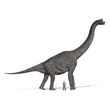
So what is a mid-sized business?
GE Capital has been defining the mid market in Australia as businesses that have annual revenues of between A$10 million and A$250 million. Average firm turnover is about A$41 million. Despite comprising just 1.4% of companies by number, mid-market firms provide one in four full-time jobs and contribute A$425 billion annually to the economy.
The federal Department of Innovation, Industry, Science and Research, which has a broader definition of medium-sized businesses as those with between 20 and 199 employees, puts the economic contribution of the mid-market considerably higher.
The mid-market campaign we successfully managed over four years for IBM targeted businesses from 99 and right up to 999, the large corporate and government sectors that IBM traditionally owned really kick in around 1,000 staff.
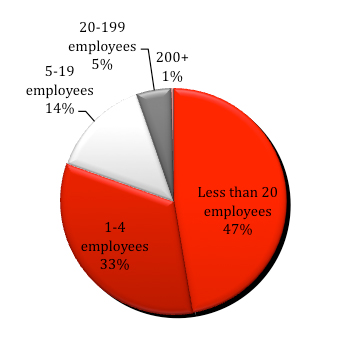
Australian Business
Most mangers still hold the belief big means better. We hold a belief businesses can only succeed today by being nimble. The reason for this is the profound change the Internet has brought to our lives. The world even quite recently was quite slow to change, and most businesses were relatively simple. Today we all compete in a world of rapid paced change and increasing complexity. So the old big business model of slowly and effectively finding savings from gradual improvements to products and services and small efficiency gains in management and procurement are no longer enough to stay competitive. Let alone stay in business.
The evidence for the decline in profitability of big business is seen in this chart. It shows one third of market leaders in their category in 1950 were also the most profitable businesses in their category, whereas today being big almost guarantees you’ll be struggling to make a buck.
Market leaders that are also category profit leaders:
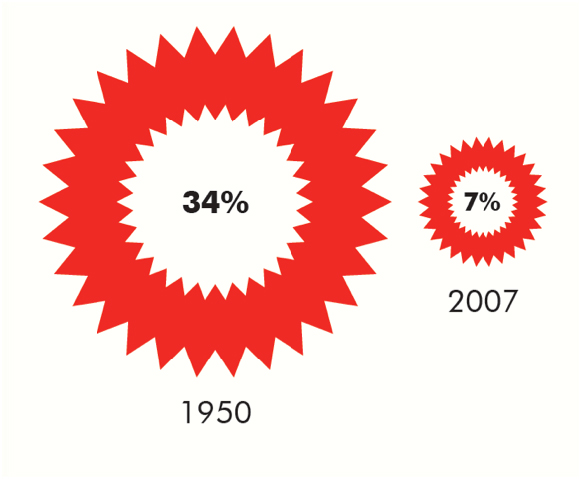
What makes big business vulnerable to challenger brands
George Shinkle is a Lecturer in the School of Strategy and Entrepreneurship at the Australian School of Business. He has been studying why big business is failing.
“Organisations grow large by becoming more efficient, so when you’re really focusing on efficiency you typically become less and less flexible. The rules and processes and procedures become more and more about keeping you efficient, constraining your ability to be flexible,” he says.
“If you talk to the CEO of a very large firm, they don’t feel as if they’ve got direct control of what the organisation’s really doing. They give guidance and they set policy but the organisation has some variance on how well they follow those things,” says Shinkle.
The learning you can take advantage of is that managers in large companies try to hide from change. Which is why, if you’re running a mid-market business, you will create your own advantage by actively seeking out things to change to differentiate from the competition.
Not too big, not too small, mid-sized business is just right
Big business is still obsessed with conformity, groupthink and doing things the way they have always been done around here. Small businesses may be the birthplace of great ideas, but they usually don’t have the scale or resources to commercialise those insights.
The mid-sized business is perfectly placed in the middle, where the distance between innovative thinkers and management that can actually make decisions is short. Unlike small business, resources aren’t so slim ideas can’t be trialled without damaging the existing business of running the business.
At a CEO Institute meeting Susan Lenehan told me the biggest frustration of the CEOs of Australian arms of global businesses she mentors is their total lack of autonomy. They are prescribed what to do by head office irrespective of local circumstances. In her words, it’s the pinnacle of the “bully culture” of big business management.
Challenger brands will prosper by taking risks
This is the great opportunity mid-sized Australian businesses are exploiting, they can leverage their ability to try changes, while the big guys are stuck in the inertia of business as usual, with its five year plans, annual targets and quarterly reporting. By challenging traditional big brands, Australians can be globally competitive in a world that is changing daily.
The real successes come from maximising returns by minimising the risks of change – we developed the challenger brand formula for growth for this very reason.
Why you need brand awareness before sales

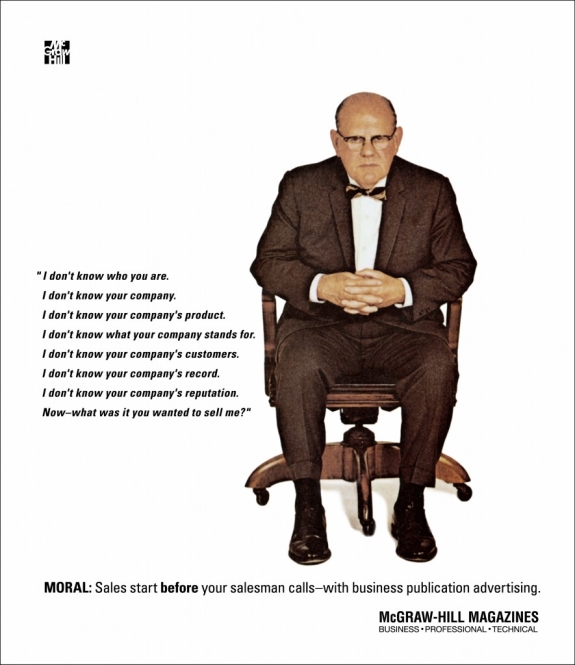
This famous ad for advertising with McGraw Hill appeared in 1958
Business owners sometimes need reminding of the timeless challenge, why would a prospect buy from you rather than one of your competitors?
For 50 years the simple answer was to spend more on advertising than the rest of your category. As marketers now realise, simple strategies in this Internet enabled world now require more complex solutions.
Challenger brands can succeed today without big ad budgets
The good news is smaller businesses can now be successful challenger brands with smaller budgets than the big brands. The staring point is to differentiate. with a singleminded story that prospects will value. you can then apply a test and learn approach to marketing across multiple mediums. Smarter strategies applied with insight will now succeed while big spending inflexible brands continue to struggle.
Read More73% of marketers say more has changed in 2 years than the past 50


Who are you going to call to advise your business on how to grasp the rapidly expanding number of marketing communications options? Usually you’d call in an expert. However, the pace of change right across the business world and the complexity of competing solutions is so great how can any individual be an expert? And big businesses may have lots of individuals, but we all know they rarely work as a team let alone communicate well with clients.
Marketing professionals are confused
A survey* by Adobe of 1000 marketers in the US shows the crisis in confidence of the marketing services.
“Marketers are facing a dilemma: they aren’t sure what’s working, they’re feeling under-equipped to meet the challenges of digital, and they’re having a tough time keeping up with the pace of change in the industry. What’s worse, no one hands you a playbook on how to make it all work,” says Ann Lewnes, Chief Marketing Officer, Adobe.
Digital marketing is full of novices
Adobe’s survey found less than half (48%) of marketers who consider themselves primarily digital specialists feel highly proficient in digital marketing. Most digital marketers haven’t had any formal training in digital marketing. No surprise really, it’s so new and evolving very few places can teach it.
The problem for business owners is how to leverage what’s new when so few people, if indeed any, know what will work. The people whose job it is to know, professional marketers, revealed in the survey the same old issues are today’s top challenges. 82% cited reaching their customers as the biggest challenge, then the uncertainty of knowing if their campaigns are working (79%), and measuring campaign effectiveness (77%) and marketing ROI (75%).
The answer for marketing your business?
Today every part of the business has to take risks
Whether it’s your accounting systems, distribution, IT or marketing, everything now is facing change. It’s hard enough to know the right question to ask anymore, let alone have the right answer. The safest option today is counterintuitive – it’s to realise you can’t predict winners anymore.
So the safe approach with marketing is no longer to set and forget. Rather than taking a long time and spending a lot of money attempting to develop the one perfect solution, try a lot ideas and mediums. And try them quickly and often.
Test. Learn. Adjust. Test again.
Learn to feel comfortable with failures. Set out to make the risks small so the stakes aren’t too high. Then go for it with a test and learn approach to marketing. The more often you fail the quicker you’ll find yourself challenging the competition and being successful.
* Source: Adobe and Edelman Berland, online survey among a total of 1000 US marketers. Marketing Staff (n=499), Marketing Decision Makers (n=436), Digital Marketers (n=263), and Marketing Generalists (n=754). September 2013
Read MoreAre fashion retailers training customers to buy on sale?
I've written in the past how Zara led the world by applying just-in-time manufacturing and data analytics to bring us fashion forward product design. This has given them an advantage over traditional retailers by circumventing the traditional seasonal approach to fashion.
Instead of waiting for the leading designers to reveal on the Paris catwalks what we'll be wearing next year, Zara's innovation was to take the Dell Computer model. Zara replenishes stock in their stores every week, see what sells, then make more of what is popular. Rather than sitting on large quantities of stock hoping people will like what style you've backed, Zara take a test and learn approach. They never back one colour or style for a full season, Zara simply adjusts what they manufacture on the fly to what the consumer wants this week.
Fashion challenger brands risk destroying the advantage they have created
Retailers are losing the power to maintain margins by encouraging a buy on sale mentality. According to Robin Givhan, the only clothes critic to win a Pulitzer Prize, with the constant turnover and turnout of items due to the ever-quickening fashion cycle, there’s no need to buy anything at full price anymore.
While bloggers and fashion critics have used social media to drive awareness and demand of the weekly fashion cycle, retailers she says are to blame for the loss of their pricing power.

"Retailers talk a lot about how the availability of show images pique the interest of consumers before the clothes are available. But I blame retailers for creating a system in which they want spring clothes in November and more shipments every five second[s] and then putting things on sale when they've only been on the racks for one second," said Givhan.
Consumers usually don't know how to establish the value of something, it's actually within the power of the seller to frame the price that they will believe is fair.
Innovate for pricing advantage
If you have innovated your way to a price advantage, don't throw away your smartly won margin. Instead, decide how you can frame the price as fair value, for instance in terms of more for the same, or faster for the same, or better for the same. Offering something for less is an approach fashion retailers are finding comes at the cost of not just profit, but long term survival.
Don't drive your category to the bottom the way Persian Rug stores have, where in every corner of the world the SALE sign on the window now means OPEN. Here's one I snapped in Hong Kong...
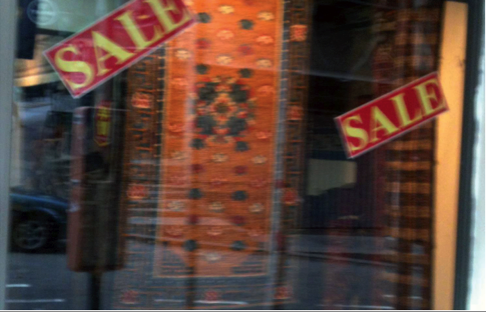
Do you have a clear point of difference to drive growth?


Staying in business has never been harder. 10,632 companies collapsed in the 12 months to March 1 2013 - ASIC also reports the number of firms being placed in administration is more than 12 per cent higher than during the GFC. Over the last few months an average of 44 small businesses were closing every day according to ABS data.
A change of government won’t change the fact the pace of change is still accelerating, the choices for customers continue growing and the decisions we all face in life are more complex than ever.
Where will your business growth come from?
These are your options:
- From existing clients
- By getting new clients
- Expanding to new locations, (interstate, overseas)
- Developing new services
- Making acquisitions
90% of businesses focus on number 1, selling more to current customers or charging them more. Yet the upside is limited.
Of the small number that go down the acquisition path most are disappointed. An AGSM survey of mergers and acquisitions showed after 3 years just 10% exceeded expectations of synergy and only 10% - 15% met expectations. The rest had failed or were in a death spiral.
Expansion and new product or service development often require a large commitment of resources and takes attention away from the existing business.
Which leaves new business as the key driver of growth. Marketing is the one proven method that can drive scalable new business growth. A successful new business program begins by confirming you have a differentiated offer relevant to today’s customer. Every prospective customer has more than one choice. What does your business have that makes it so special they have to choose you?
Customer alignment, simplification and innovation
Here’s a simple technique that GE Capital employs to keep their business differentiated in this time of rapid change. 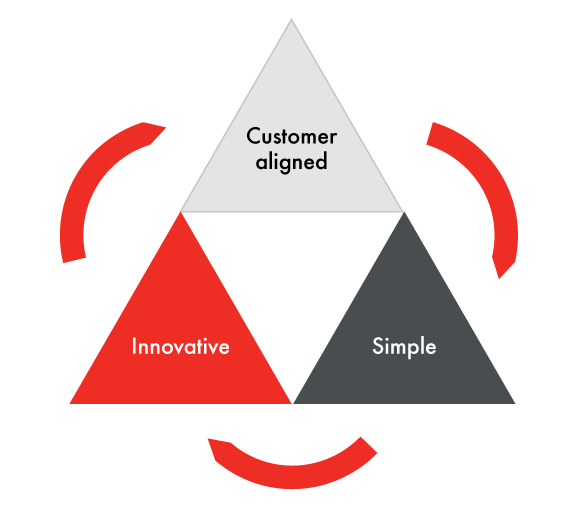
Customer aligned
- Employees know which customer segments we serve and what their top 3 needs are
- Our organisation rallies around these needs (customer facing & support departments)
- We continuously track customer metrics at a transaction, product and business level
- We respond to customer feedback fast
Simple
- We do less, better
- Our customer processes are intuitive
- Our internal processes are as easy as our customer processes
- We routinely identify and eliminate the bottom 30% flow value processes, reporting and meetings
Innovative
- We encourage, empower and reward staff who challenge the status quo
- We launch new ideas fast (< 45 days average)
- We have a full pipeline of ideas linked to incremental volume
- We invest a significant amount annually on innovation
Differentiation for new business growth
Don’t hold your breath waiting for the government to simplify regulation, align their policies with your needs or innovate the country’s way to prosperity. Look at your current structure, reconsider what the business currently offers and determine a positioning that will differentiate you from your competition. Today.
This is just one of the tools UNO uses to ensure when our challenger brand clients invest in marketing, the returns will be worth the effort.
Read More
There are few categories more sophisticated at marketing than fast food. For 50 years McDonalds has been fine-tuning their brand marketing driven machine in Australia. Other brands may talk share of voice or share of wallet, McDonalds is famous for wanting the largest share of stomach in the country.
The business is a great example of how to upsell, cross sell and find new reasons for customers to visit. From breakfast muffins through burgers and happy meals to soft serves and late night treats, washed down by McCafe coffees in between. From Pasta Zu to chicken nuggets to who knows what else a machine can transform animal castoffs into.
Want fries with that?
All of these tactics are an excuse to get more people to buy fries more often, it's where the big profits are made. Makes you wonder how anyone can compete? If you don't work for an omnipotent global business there is evidence of hope. Roy Morgan reasearch released in August 2013 shows just how well new competitors can do by choosing to take a challenger brand positioning.
A case study in how positioning can outsmart the big brands
Hungry Jacks came much later, and has never had the footprint or the ad budget to compete head on. What has worked long term for Jack Cowin's fast food challenger up against a global heavyweight, is a differentiated positioning that gives it a clearly defined space to compete in. "The burgers are better at Hungry Jacks."
From day one they lived up to that positioning statement, better burgers; either with biigger burger patties, actual lettuce instead of a miserable pickled cucumber, to the first Angus beef burger, then bacon and now organic beef. Single mindedly niche focused, and better for it in the minds of customers, who consistently rank Hungry Jacks above Maccas.
Long-term customer satisfaction in fast food comes from smart positioning. Chart: Roy Morgan, August 2013
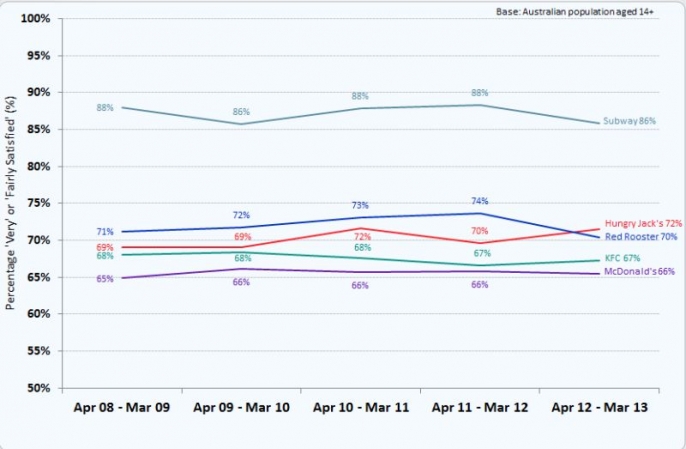
Challenger brands create new terms to compete on
Subway shows the rewards of zigging when the competition zags. While fast food leaders spent their product and promotion strategies on short term price promotion or new themes, from changing with the seasons, think summer pineapple burgers to following fashions, think cajun sauce. Meanwhile Subway went where no fast food had ever successfully gone before: the good for you. positioning.
The chart shows the relative strength of Burger King's "do less of the same, better" approach, and Subway's "do something completely different" model. Both are positively recognised by the consumer and continue to command a price premium to the slower to innovate fast food competition.
What size is a typical marketing budget?

How much is the right amount to invest in marketing?
Depends who you ask. The CMO Council asked hundreds of chief marketing officers around the world across categories how big their budgets are. While this was post GFC, it gives us a useful benchmark when planning ahead.
The starting point for setting a budget uses a top down approach based on your revenue. The chart we've made below shows the percentage of revenue invested in marketing by business to business firms.
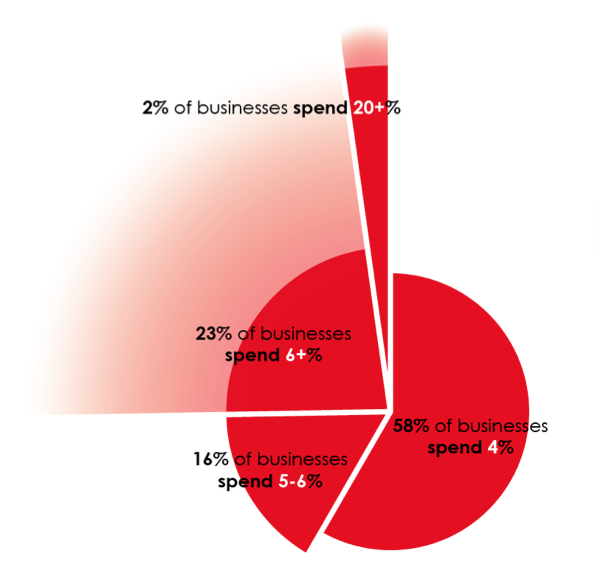
Percentage of revenue invested in B2B marketing
2010 CMO Council Survey
Interestingly, the consensus view amongst those surveyed was that a new brand launch required a minimum investment of 20% of revenue. As we can see from the chart, either there aren't many new brands launched in any year, or the majority aren't spending enough to ensure they don't fail.
Another way of determining the right size of budget is to compare how much is spent according to the size of the business.
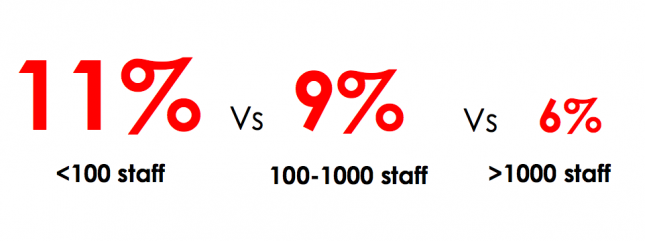
Percentage of revenue invested in marketing by company size
2010 CMO Council Survey
We shouldn't be surprised that as businesses establish themselves and grow, the number of staff grows. As they grow, the relative proportion of their revenue invested in marketing decreases. Marketers understand the long term nature of judging the return on investiment in marketing. Marketing that is consistant delivers compounding returns, a relatively large initial spend will pay dividends in the long term.
Average marketing budget for FMCG brands
A Go-to-Market survey in 2012 found this spread of investment by revenue of FMCG brands:
% of revenue % of companies
No budget 1.1%
0 - 2% 28.6%
3 - 5% 33%
6 - 10% 21.1%
11 - 15% 8.6%
16 - 20% 4.3%
20%+ 3.2%
You can use these percentages as a starting point for framing your marketing budget and then compare to the result of viewing your requirements from a bottom up view.

Bottom up marketing budget approach
Create a list of activities you plan to undertake across your integrated marcomms plan and estimate the required investments for each. Balance and adjust for frequency, reach and coverage. Consider set-up costs for all mediums and a realistic figure for content creation and creative, remembering the better the idea the less times your audience needs to see it to get a result. Factor in research and tracking and an allowance to have the flexibility to react and respond. Remember to allocate around half your total budget for labour, across both internal and outsourced agencies for development and management throughout the year.
Depending on the particular segment your brand is in, the consensus is a B2B marcomms budget needs to be between 3 and 6% of revenue and for FMCG between 6 and 12% to have at least a competitive share of voice.
Read MoreThe most and least trusted professions
Every year Roy Morgan releases a ranking of the trust Australians have for each of the professions. Advertising is down and real estate salesmen up in 2013.
Here are the jobs as they rank for trust in Australia
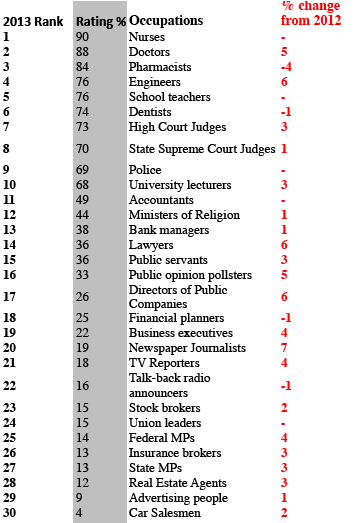
How does this compare on a global basis? See the global trust index.
Read MoreThe Naked truth on Rudd's interview for ads scandal

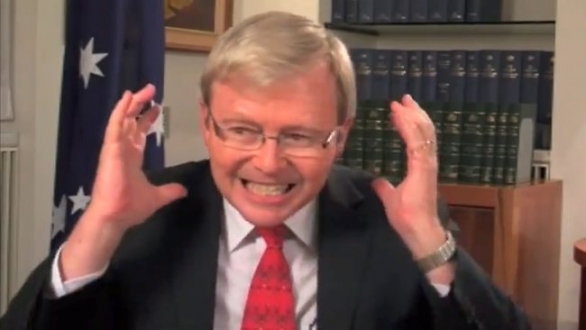
You probably already have an inkling the public rate marketers and ad people at the bottom of the trust scale for professions. You're right, they are down there with politicians. Something happened this week to reinforce the view that neither can be trusted, it's a classic example of an "whatever it takes who cares about the ethics" attitude.
Controversy blew up when Sydney based Naked Communications was exposed while working on a project for Labor when it offered video interviews with PM Kevin Rudd to online youth publishers in return for free online ad space.
Further blurring the lines between “an interview”, and an ad campaign, the agency wrote to Faifax owned The Vine they were “particularly keen for a deeper relationship (including putting investment behind your content on YouTube).”
They also encouraged the online publication to provide “access to pro-Labor or pro-NBN talent.”
When found with their pants down, Naked were fired by Labor. The Sydney Morning Herald’s political reporter, Jonathan Swan, who broke the story, said “it seemed very odd” that Labor was oblivious to the deals offered to online youth sites.
The agency’s CEO claimed no knowledge of the deal, blaming a younger staff member. Indeed, the day after it blew up the agency planner responsible was “no longer in the building”, having left for a holiday in the UK.
What has been adland's reponse to this question of maintaining standards?
Next day the Creative Director of Wonder wrote in AdNews “how much responsibility are we giving young and inexperienced executives? I think too much. Our industry is more impressed by 20-something backward baseball cap-wearing gamers that impress us with their social media savvy than wise old owls. Where are our wise old owls? Nobody could ever accuse the marketing industry as one that eats their young. Quite the opposite, we assassinate the old and we call anyone over 50 old. Mike Wilson (CEO) is Naked’s wise old owl and the bloke is only in his 40s.”
He then suggested the team at Naked vote Abbott to avoid a Labor backlash. This received some wise comments, my favourite from No Wonder of Paddington:
"Wisdom is not the province of age, and this is not an 'odd judgement error'. It's a failure from top down to create a culture of ethics... that at all times forces doing the right thing to trump making a splash for your client. Wilson may be the straight shooter he's characterised here to be, but as the leader of the pack, he's ultimately responsible for the culture that would spawn the actions of that 'rogue executive' who was shown the door"
"This isn't the first time that Naked has been guilty of pushing the envelope at the expense of common sense, and more importantly common decency. What's worse is that the creative drive to market at any expense has had a poisonous influence on the business in general, and in some corners legitimised the art of the stunt and the bad habit of erasing the moral line to such an extent that many of the young guns don't even know it exists."
"It's the agency that should take the fall in the end, not just the employee directly responsible, and encouraging them to vote for Abbott in an attempt to avoid the negative reaction from everyone that they richly deserve shows us all just how jaded the industry at large has become. Sad and sadder."
SMH's Swan labeled the agency “a bit wild west, they’ve got a cowboy reputation” and said they have a history of “doing things a bit off-piste”. Swan also mentioned the infamous fake Facebook Witchery coat campaign which duped both mainstream media and social media users in 2009.
When does online content become advertising?
According to the ACCC and AANA it’s one and the same in the eyes of the law, as we can see from the new Code on marketing communications that encompases social media.
Gabriel McDowell, MD of PR firm Res Publica pointed out the new risks inherent in attempting to leverage digital channels: “From a crisis management perspective, and based on the reported facts so far, I think the ALP has reacted promptly and appropriately to try to limit reputational damage to the Labor brand. They have made it clear they didn’t sanction the offending proposal and firing the responsible agency was a justifiable response given the seriousness of its misjudgement.
"And there can be no doubt that it is a whopper of a misjudgement because building trust and understanding between a brand and its public is the fundamental objective of any communication campaign and deliberately blurring the lines between editorial and advertising can only erode trust when it is uncovered.”
"It has never happened before. My mouth was on the ground. Young people are politically engaged and this is not the way to go about appealing to them. It is why we tend to shy away from the major parties."
She told AdNews it was "exactly the sort of thing that is killing media", but that brands generally grasped the value of editorial over paid content.
The challenge for the communications industry is while we may have self-regulation, only a handful of agencies are Accredited by the Communications Council. UNO is, Naked isn't and most clients don't appreciate the difference. As I commented to AdNews, "what's the point of having an agency Accreditation scheme when people arrive at work having forgotten to pack the moral compass. If we want to be regarded higher than real estate salesmen, which the latest research shows we don't, both clients and agencies need to keep briefs away from the irresponsible."
Will digital spell the end of editorial integrity?
This has all happened less than a week after Adnews editor-in-chief Paul McIntyre expressed a fear for the future of publishing as the title becomes a defacto re-publisher of PR releases and sponsored events. This is what he said in an open editorial:
"Change can be painful but equally stimulating. Just as long the industry knows where it’s all headed and in what direction it is pushing its industry media. It won’t be too far away, for example, when you all can hack back your budget for PR operatives. And PR types, brace for a much harder slog. Seriously, most of you won’t be needed. The deluge of PR-generated ideas and story angles is rising rapidly while the ability for business-to-business media to cover it is declining at the same pace. Don’t forget that. Okay, sorry, rant over."
Read More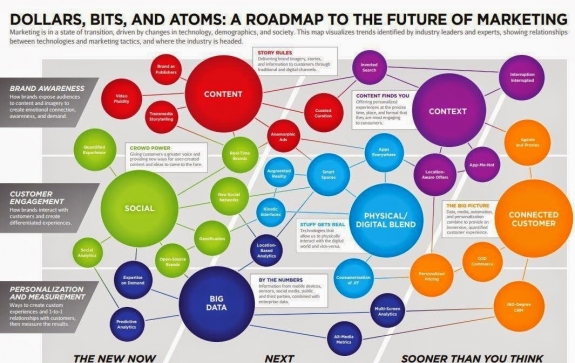
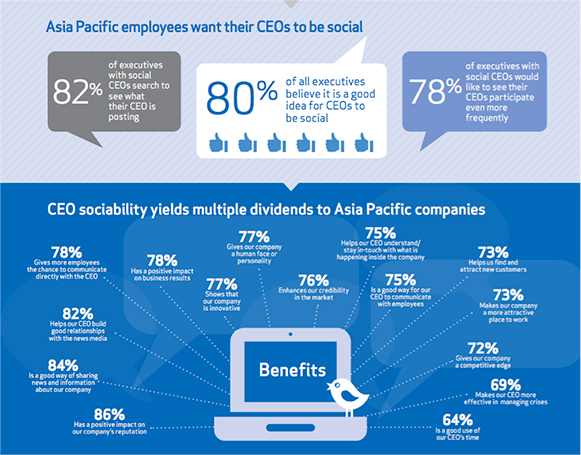
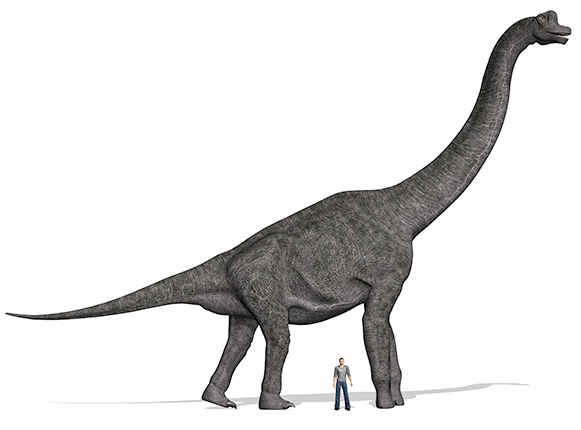





Scan the QR code for our contact details.
Download the Neoreader app.
© COPYRIGHT 2013 UNO marcomms Privacy